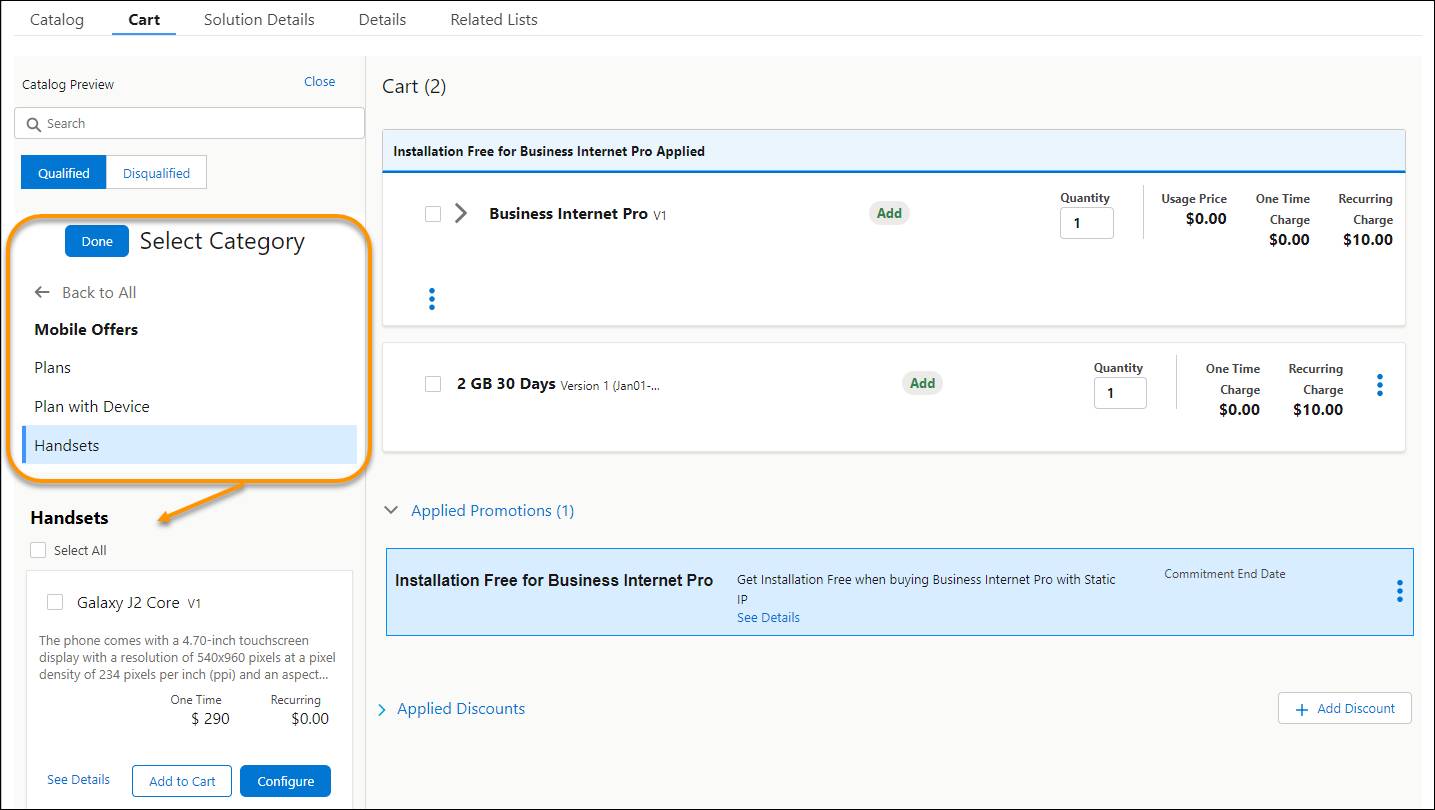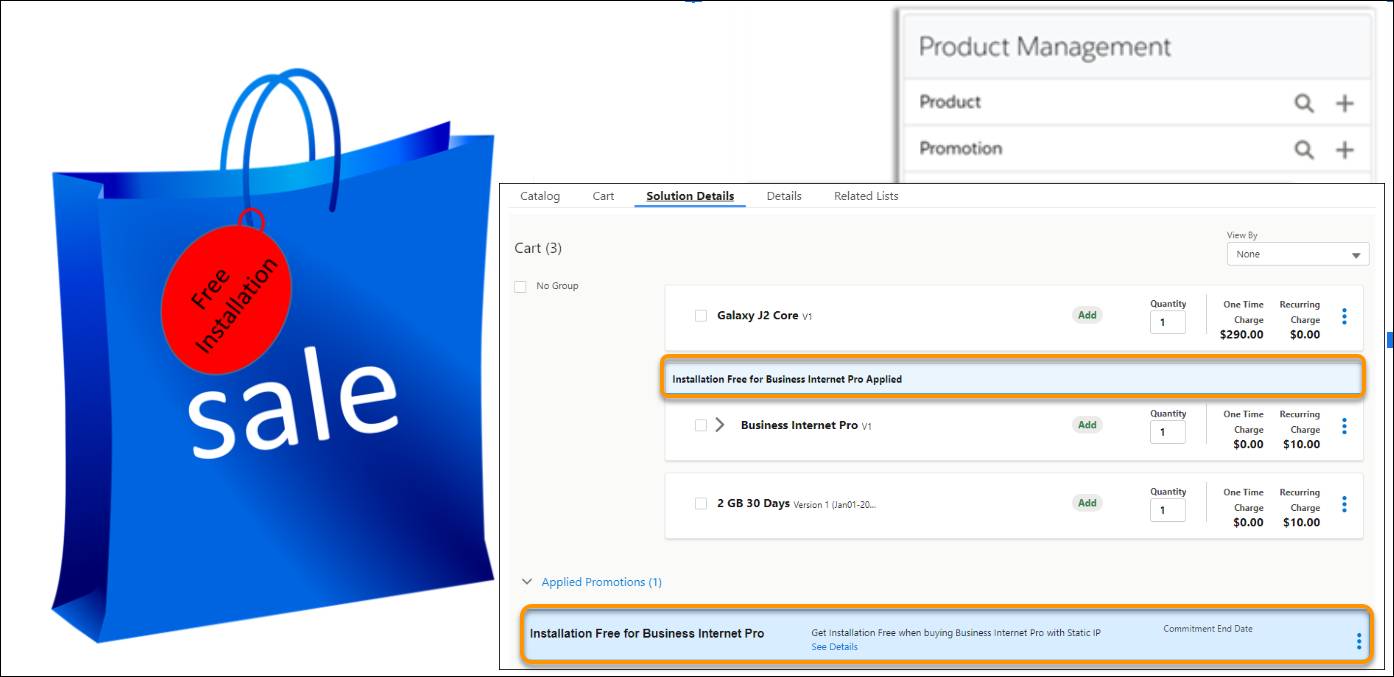Discover Industries CPQ Functions
Learning Objectives
After completing this unit, you’ll be able to:
- Explain how the shared catalog supports browsing and product configuration.
- Identify the different pricing functions available and describe how to use them.
Product Browsing and Configuration
Industries CPQ ensures accurate quotes are built and approved before you create and submit the perfect order for the customer. In this unit, you learn about the core functional components of Industries CPQ and the applications that support them.
Here you see an example of the cart. This is the out-of-the-box shopping-cart UI provided with Industries CPQ.

You develop the cart using Lightning web components, so you can change how it looks and works.
Industries CPQ uses information stored in the shared catalog to offer catalog-style browsing with a single view to configure and price offers. In this example, only handsets appropriate for the customer are displayed in the browse panel. The sales rep adds the selected handset to the cart and then configures it to meet the customer’s requirements.
Use the cart to configure, price and, if required, group products and services for the customer. In this example, the cart already contains two product offers, which are Business Internet Pro and 2 GB of data for 30 days. The Applied Promotions section shows a promotion offering free installation.
Your salesperson or customer sees just one cart interface. However, depending on the implementation, multiple carts can work together behind the scenes, such as a group cart for multisite quotes and a working cart for bulk processing. Read more about the group cart and working cart in the documentation linked in the Resources section.
Product Pricing
Industries CPQ uses the pricing and rules created by your implementation team in the shared catalog to calculate prices and discounts. Pricing and rules are based on context and configuration. Prices can be adjusted in the quote if required.
The shared catalog pricing system is component-based, with reusable items such as charges, discounts, adjustments, costs, and penalties. These items can be:
- Recurring charges, which means they happen regularly, such as monthly mobile phone rental charges
- One-time charges, for instance, the purchase price for a mobile phone handset
Industries CPQ creates and stores pricing components independent of products. This makes it easy to apply new pricing structures to products and services. To be selectable for a customer, a product or service must be active and associated with a price—even if that price is $0.
Pricing
Industries CPQ gives you the option to:
- Apply attribute-based pricing to reduce catalog complexity.
- Adjust or override a price without changing the base price of the product or service.
- Offer customers the option of paying for part or all their order with loyalty points.
- Change the price of a product automatically over time.
- Implement complex pricing calculations with matrix-based pricing.
- Customize the pricing process by adding steps, such as a step to accommodate tax calculation.
Promotions
A promotion bundles a product with special pricing. The pricing may be for a limited time, for specific types of customers, or for certain products. Examples of promotions include:
- A Black Friday deal, where a bundle of products are offered at a reduced price for a week in November
- A College Student Offer, where college students receive a free exercise plan and reduced subscription fees as part of their gym membership
- Free service installation for new business customers, as shown in the Solution Details of an example quote here.

See that the free installation is shown in the offer section of the cart, but the promotion that applied the free installation is identified in the Applied Promotions section.
Promotions, and the rules that govern promotion availability, are created in the shared catalog, but applied in the cart.
Qualification and Validation
As you create customer quotes and orders, Industries CPQ applies rules to ensure customers receive the right products and services at the correct price. You can also use rules to assess appropriate penalties for product or service changes and cancellations.
Who creates rules, and where? Your product administrator, in the shared catalog, of course! When a sales rep creates and edits a quote or order, Industries CPQ applies the rules to ensure your product and service offers are relevant and available to your customers. Rule types include context rules and advanced rules.
Context Rules
Filter the products, promotions, and price lists in the shared catalog using context rules. This type of rule ensures that customers can only select and add items to the cart that are relevant. Context rules also qualify price list entries and pricing adjustments in the cart. You can use the context rules framework for Salesforce Industries API caching, which digital-commerce solutions often require.
Advanced Rules
Use advanced rules to establish product compatibility or configuration. For example, advanced rules can recommend upsell and cross-sell options, stop your sales rep from adding incompatible items to a quote, or reduce configuration options based on customer selections.
Your product designers and administrators need a good understanding of your products, services, and end-to-end customer requirements before setting up rules.
Asset Amendment
In Salesforce, an asset represents a product or service the customer has purchased. The screen capture shows the Salesforce asset view on a customer account.

The Change to Quote, Change to Order, and Move buttons direct you to guided processes to renew, cancel, upgrade, downgrade, suspend, or resume products and services. Any changes made are tracked and recorded on the assets.
Industries CPQ Interfaces and Implementations
Industries CPQ uses an interface-implementation paradigm. So you can quickly and easily adapt the business logic to perform specific tasks, such as pricing and the application of rules. For each interface, your implementation team can choose an existing implementation, extend the functionality with a hybrid implementation, or create an entirely new implementation to suit your requirements using Apex code.
The Verdict
There’s a lot more to Industries CPQ than Sophia first realized. Now that she knows the core functionality, she wants to learn more—namely, how to make all this happen? Let’s move on to the Industries CPQ solution map to find out.
